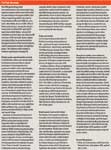Campaign Mounts to Curb Counterfeit Drugs
Import controls and risk strategies aim to promote quality and spur new drug development.
Drug counterfeiting has become big business for international criminals, lured by easy profits and relatively low risk of prosecution and penalties. Analysts calculate that counterfeit drugs cause 100,000 deaths worldwide each year and provide approximately $75 billion in revenue for illegal operators. Distribution of phony medicines has become such a global public health threat that it made the agenda of the Group of Eight (G8) world leaders at their May 2012 annual meeting. G8's concluding declaration supported exchange of information on rogue Internet pharmacy sites and on methods to combat counterfeit medical products.

Jill Wechsler
The Chinese government is looking to counter its reputation as the lead global source of fake and adulterated medicines by cracking down on counterfeiters of drugs and healthcare products. In a raid last month, some 18,000 law officers detained nearly 2000 suspects and seized approximately $182 million in illegal remedies for diabetes, high blood pressure, cancer, and other conditions. Unfortunately, a similar effort in 2011 led to the arrest of 114 suspects and seizure of $30 million in bogus products, but that apparently did not deter the counterfeiters.
An EU report on customs enforcement in 2011 states that medicines accounted for the most (i.e., 24%) of detained articles. The document notes that counterfeit drug enforcement units broke up rings in Spain and the UK and uncovered fake HIV medications and unauthorized asthma drug inhalers. Counterfeiters no longer focus just on "lifestyle" drugs for erectile dysfunction and weight-loss, but market medicines for a range of serious conditions.
More opportunities
Despite more active anticounterfeiting efforts, shortages of key medicines in the US and Europe have created new opportunities for illicit traders, while ever-longer manufacturer supply chains open the door to diversion and theft. In the past two years, FDA has uncovered Internet sales of counterfeit Abbott pain medicine Vicodin, fake Phentermine tablets, and a phony version of the "morning after pill" called Evital.
In May, FDA warned consumers and health professionals that Internet operators were selling counterfeit versions of Teva Pharmaceutical's Adderall (amphetamine and dextroamphetamine). Severe shortages of the short-acting treatment for attention deficit hyperactivity disorder prompted patients to seek new sources, but many of these products either lack active ingredient or contain dangerous substances.
Patients and physicians also are attracted to unknown suppliers by lower prices, as seen in the wave of counterfeit Avastin (bevacizumab), Roche's cancer therapy, which was purchased by dozens of US oncologists. FDA continued to uncover sales of the counterfeit product, in some cases under Avastin's Turkish brand name, Altuzan, despite widely published warnings in February that the phony vials lacked the key active ingredient. FDA has sent letters to more than 70 doctors and clinics in 28 states warning against purchasing the illegal product and launched a major investigation of alleged distributor Canada Drugs and other parties (1). Several online pharmacy operators were arrested, along with importers and distributors.
Track and trace on hold
FDA believes that the best way to keep counterfeit, diverted, and adulterated drugs out of the US supply chain is to establish a comprehensive drug track-and-trace system that can account for legitimate products at every step in the distribution process. In testimony last March before the House Energy & Commerce Health subcommittee, Janet Woodcock, director of the FDA Center for Drug Evaluation and Research (CDER), emphasized the need for a system that can provide complete records on all parties involved in distribution after a product leaves the manufacturer. FDA can set standards for drug identification and authentication, as seen in recent guidance for manufacturers to implement standardized numerical identification for prescription drug packages, Woodcock explained. But the agency lacks explicit authority to require implementation of a national tracking system throughout the supply chain. Without such a system, added Allan Coukell of the Pew Charitable Trusts' Pew Health Group, there is no way to check whether an individual vial or bottle is authentic or fake.
Industry opposes such an approach as unworkable and too costly and blocked it from inclusion in the FDA Safety & Innovation Act (FDASIA) approved by Congress in June. Manufacturers claim that the technology to support a fully electronic tracking system is unreliable, and that establishing such capabilities would raise the cost of medicines by billions of dollars. Pharmacists, moreover, protested having to check the authenticity of every drug unit coming in from wholesalers and distributors.
The Pharmaceutical Distribution Security Alliance (PDSA), backed by manufacturers and wholesalers, instead supports the RxTEC model that calls for manufacturers to establish data systems that hold individual drug unit serial numbers. While PDSA claims this system could help regulatory authorities validate products, detect counterfeits, and manage drug recalls and returns, Coukell objected that because the thousands of bottles in a lot may travel through multiple distributors, the tracking system needs to link unit serial numbers to shipping cases in order to know where a black-market vendor obtained illegal goods.

Hot-Topic Roundup
The Senate proposed to include the RxTEC proposal in its initial version of FDASIA, but the House did not agree, and pressure to approve a final bill by the end of June prompted the legislators to drop the issue. Instead, FDASIA contains important provisions that can help block the import of violative products and imposes stiffer penalties on counterfeiters. FDASIA allows FDA to destroy certain counterfeit or adulterated imports instead of having to return them to sender and strengthens requirements for manufacturers to notify FDA of stolen products or evidence of counterfeiting. Trafficking in counterfeit drugs was made a criminal offense, and persons who knowingly and intentionally produce counterfeits or sell them would face fines up to $4 million and 20 years in jail.
These added authorities can help FDA uncover and prosecute drug counterfeiters, now a task for the Office of Drug Security, Integrity and Recalls (ODSIR) in CDER's Office of Compliance. FDA also continues to encourage manufacturers to incorporate physical-chemical identifiers into drug products, as seen in a guidance issued in October 2011 that describes considerations for adopting such formulations for solid oral dosage forms.
Agency officials continue to press for a more comprehensive drug-tracking system, while also seeking additional opportunities to collaborate with other government agencies and international organizations to combat counterfeiters. FDA works with the Commerce Department anti-counterfeiting task force and federal law enforcement and customs agencies, as well as with the World Health Organization, to build global capacity for monitoring supply-chain threats. The agency participated in an INTERPOL-led exercise to target websites supplying illegal and dangerous drugs.
A report from the Institute of Medicine due in 2013 will outline further anticounterfeiting proposals for collective action among regulatory authorities, along with actions that the experts feel that industry should address. FDA Commissioner Margaret Hamburg will discuss these and other efforts to combat drug counterfeiting at the annual Partnership for Safe Medicines Interchange at the end of this month. All parties will be looking for effective and affordable strategies for improving drug tracking through the supply chain and for distinguishing genuine from adulterated medical products.
Reference
1. C. Weaver and J. Whalen, Wall Street Jour. (July 20, 2012).
